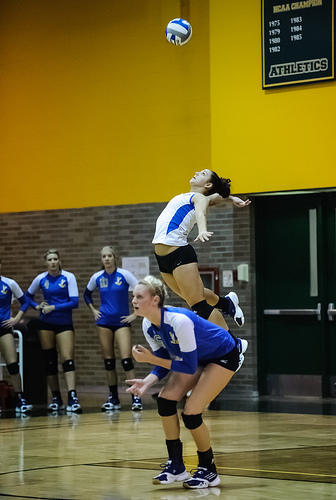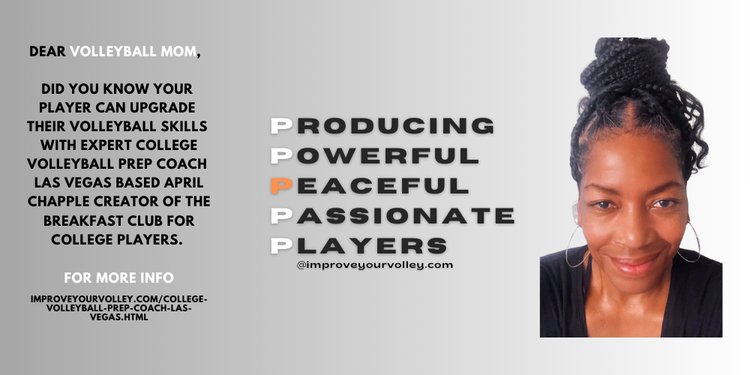 Dear Volleyball Mom,
Do You Know What Sets My Private Volleyball Training Apart From Anyone In Vegas?
I invite You to read what my private volleyball training mission says before considering hiring me as a private volleyball coach because I'm not available for everyone.
Dear Volleyball Mom,
Do You Know What Sets My Private Volleyball Training Apart From Anyone In Vegas?
I invite You to read what my private volleyball training mission says before considering hiring me as a private volleyball coach because I'm not available for everyone.Four Blocking in Volleyball Tips To Improve Your Defensive Skills Fast
An important blocking in volleyball tip is to watch the hitter you are going to block in order to pick up important clues that'll help you block the hitter.
When blocking in a game do you watch the ball or do you watch the hitter?
Learn which options to choose and why.
Regardless of the types of blocking in volleyball that you do its always important to watch the hitter or hitters that you are going to block in order to pick up important clues that will help you stop the attack at the net.
Regardless of the types of blocking in volleyball that you do its always important to watch the hitter or hitters that you are going to block. Watch as Hailey and Karime work on swing and traditional blocking footwork.
Volleyball Block Tips:
Learn These Skill Cues For Blocking in Volleyball
"Ball Setter Ball Hitter"
Ball - Setter - Ball - Hitter
Ball - Setter - Ball - Hitter is the pattern of movement your eyes as you are blocking in the front row (also the back row defense but we will get back to that later) should follow when in the front row, after your team's server has served the ball over the net.
These are the places you should be looking at, in other words where your eyes should be looking...to get clues as to who and where the opposing team now on offense intends to do with the ball (give the ball to), for their third contact... an attack hit that will send the ball back into your court.
Your job as a blocker is to stop that ball at the net.
These tips about blocking in volleyball will show you how.
Watch the blocking footwork practice we do in Volleyball Voice Boot Camp classes.
Blocking in Volleyball:
Learn Skill Cues For Blocking
"First Watch The Ball"
The Ball
Once your server serves the ball over the net to start the rally, you first want to track with your eyes the BALL that's being passed.
- Why?
- What are you looking for?
- What are you trying to quickly evaluate about the pass?
- What information do you need to quickly get that will help you make a good volleyball block action?
If its a perfect pass that goes right to the setter then you know the setter doesn't have to move off the net to go chase a bad pass.
Okay so as a blocker that will tell you right away the setter is in a position to use ALL of her possible hitters to run an offense.
If three hitters are in the front row then she has three players she can set to.
If there are two hitters in the front row then she can easily set those two hitters or try to dump or attack the ball herself.
If the pass was a bad pass that forces the setter to move off the net and chase the ball down...now as a blocker you say to yourself "Self, the setter is in trouble and can't make a perfect set to all of her possible front row hitters!
If it was a perfect pass, now you watch the setter's body language and/or hand position.
Because of where and how she is chasing the ball down, WHO is the most likely hitter or hitters can she set or give the ball to..in this situation?"
"By the way, good job, Self!"
Blocking in Volleyball:
Learn Skill Cues For Blocking
"Then Watch The Setter"
The Setter
Once you've quickly made a determination on the pass, now your eyes go to the Setter.
If it was a perfect pass, now you watch the setter's body language and/or hand position.
Some setters will show with their setting body position, that they intend to make a back set because they arch their back alot when then do, but when making a front set or a set to the middle, they don't.
These are the types of skill cues and clues while blocking in volleyball that you are trying to read and interpret in order to improve your defensive skills!
If it was a bad pass you do the same thing.
But because you've identified that the setter is in trouble and can't easily deliver a perfect set to all her possible hitters, you look to pick up clues from her body language.
Is she running off the court or to her back court with her back to her hitters?
If that's the case, she will probably not even be able to set the ball with her hands but will bump it up in the air.
Blocking in Volleyball:
Learn Skill Cues For Blocking
"Now Peep The Ball Again Right Quick"
The Ball
Once we've glanced or watched the setter to get some information about what she is about to do, now we watch the ball she just touched.
As a blocker you need to watch where's the set going? Is it a high ball or a faster set like a "Hut" or a "Go"?
- Where's the set going?
- Is it a high ball or a faster set like a "Hut" or a "Go"?
- Is the ball going to the hitter in front of me or to the middle or to the other hitter in front of my teammate on the other side of my middle blocker?
Blocking in Volleyball:
Learn Skill Cues For Blocking
"All Eyes On The Hitter"
The Hitter
Once you see that
- your hitter, the hitter in front of you is getting the ball and
- you quickly note what type of set they are going to get--by looking at the type of ball the opposing setter has set to your hitter
- you now want your eyes to focus on your hitter
Now hopefully from these volleyball block tips you've found out a sure way to increase the number of blocks you can successfully perform in a match.
Do You Follow Me on Pinterest?
 Private or semiprivate volleyball indoor/sand lessons are an excellent way for young Las Vegas high school volleyball players to quickly improve their individual skills through a private or semi-private coaching experience.
These lessons are conducted by former pro volleyball player, former USA Volleyball High Performance instructor and Evaluator and Tstreet Vegas 18s head Coach April Chapple on a weekly basis.
Sign up now!
Private or semiprivate volleyball indoor/sand lessons are an excellent way for young Las Vegas high school volleyball players to quickly improve their individual skills through a private or semi-private coaching experience.
These lessons are conducted by former pro volleyball player, former USA Volleyball High Performance instructor and Evaluator and Tstreet Vegas 18s head Coach April Chapple on a weekly basis.
Sign up now!Follow me on Pinterest Volleybragswag to improve your game even faster!
I share alot of individual, partner and easy-to-do volleyball serving drills we do in class with my followers.
Many of these volleyball practice drills you can do at home by yourself or try at your next practice with your teammates.
If you're a B team or JV player trying to make varsity next year...your goal should be to complete 1000 reps a day of at least three of the basic skills on your own...volleyball passing, serving and setting should be at the top of the list.
How To Play Volleyball: Where Do You Go From Here?
We know where you need to go now! Here are three options:
- Learn more about Blocking by clicking one of the links in the Related Links below.
- Follow the suggested reading on our Sitemap page Learning How To Play (Sitemap)
- Or visit the pages in the How to Play Volleyball section in the drop down menu at the top of the page to get started.
Related Links:
Blocker Footwork and Timing For Making A Good Block
SUSCRIBE
To My Email Newsletter Below!
From Lady Vol to Legend: Coach April Produces Powerful Passionate Players...is that you?
What Are You Looking For?

Hi there!
Thanks for stopping by. Hope you learned something today that will help you reach your volleyball goals.
Be sure to subscribe to my email newsletter so you can learn more each week!
Stay strong! Stay motivated!
-Coach April

SUSCRIBE
to my email newsletter below!
Vegas Volleyball's Unsung Heroes: Celebrating Moms with Peace Love Volleyball Shirts
Ready to energize your volleyball mom journey?
Subscribe to my 'Producing Powerful Passionate Peaceful Players' email list above on ImproveYourVolley.com.
You'll receive energy-boosting tips, exclusive insights from me, Coach April Chapple on maintaining momentum in volleyball.
Let's power up the Vegas volleyball scene together!
Recent Articles
-
Frequently Asked Libero Volleyball Position Questions Answered
Apr 14, 25 08:10 PM
I answer the most frequently asked libero volleyball position questions many players and coaches ask that will help you learn about the player responsibilities. -
Coach April's Peace Love Volleyball Phrases For T-Shirts Honor Moms
Apr 13, 25 03:49 PM
Whether on the court or in everyday life, April Chapple's volleyball phrases for t-shirts are serving inspiration for players and moms, one message at a time. -
What Is A Setter In Volleyball? My Setting Guide With Answers To FAQs
Apr 13, 25 12:36 AM
Learn what a volleyball setter is from a champion coach. Get expert insights, training tips, and proven strategies for volleyball's most strategic position.











































